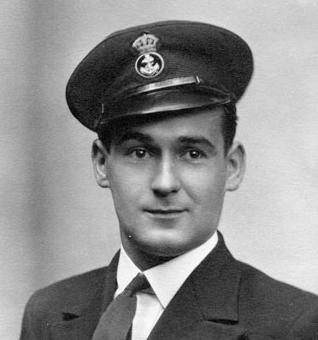 I guess we're on a WWII Royal Navy kick for awhile.
I guess we're on a WWII Royal Navy kick for awhile. I can't even imagine.
TO DIE in a hospital bed was not the end Ted Briggs expected. He thought he had copped it when, at 16 and on Atlantic patrols on HMS Hood in 1939, he looked up to see a black object “as big as a London bus” tumble gently out of the sky and pepper the deck with shrapnel. Or, some months later, when a stick of bombs from an Italian aircraft blew him down the ladder from the flag deck, giving him a cut on the nose that bled like a torrent. Or the moment when, inching out along an upper yardarm to retrieve a halyard (for he was a signal boy), he saw the engine-room safety valves pump out a column of red-hot steam, and expected to be boiled alive.
The life of a boy-sailor on the navy’s prize battlecruiser was no cakewalk. From Fall-in at 05.25 to Turn-in at 20.45—swinging into a hammock under a heavy wool blanket, his mouth still dry with gritty cocoa—came constant swabbing and scrubbing of the grey corticine decks, interspersed with instruction and drill. That was in time of peace. But Mr Briggs knew only two months of quiet before he was ordered to hoist flag “E” and “show up 46”: “Commence hostilities against Germany.”
He had not joined the Royal Navy to fight. He had joined because, one day in the summer of 1935, he saw from the beach at Redcar in North Yorkshire a long, slim, huge ship at anchor far away. It was the Hood on a visit to Hartlepool. Mr Briggs, a straightforward man, was embarrassed to mention her “beauty” and “grace”, but that was what he felt. It was a love affair. He tried to join the navy the next day; a man told him, since he was 12, to come back later. The day he eventually went on board the Hood, at 16 at Portsmouth, was the time he first felt that peculiar mixture of queasiness and wild excitement that assailed him each time he was piped to Action stations and the big guns opened fire.
In his many writings and talks about the Hood, Mr Briggs recalled great happiness on board. Though patrols near the Arctic to intercept German ships brought mountainous seas and soaking, freezing spray, the “mighty Hood” was a vessel on which he felt cared for. He was proud of her and the tasks he did for her: officers’ messenger to and from the cabins of the braided top brass, and signal boy, running up the flags as needed and securing them, on the high yardarms, with Inglefield clips.
The Hood was an old ship, rusty and slow, built in 1916 and never properly refitted or armoured since. She performed well in the North Atlantic and the Mediterranean, leading the force that destroyed the fleet of Vichy France at Mers-el-Kebir in 1940 (an action Mr Briggs found “revolting” though, as ordered, he tremblingly clipped up the white-and-red bunting that meant “Open fire”). But her plating groaned in heavy seas, and water sloshed almost continually over the afterdeck. “Briggo” learnt quickly the niceties of crapping without being washed away. But, boy as he was, he fretted about the ship. Well over his head, officers with “scrambled egg” on their chests did not worry until too late about the thinness of her deck-armour.
Roll out the barrel
On May 23rd 1941 the Hood hoisted her battle ensign. She had been shadowing the better-armoured Bismarck, a “jumped up” ship as Mr Briggs thought of her, for 30 days or so in the North Sea; now she was closing in. As the German ship fired her 15-inch shells, Mr Briggs, high on the compass platform, saw a vast sheet of flame blow up in front of him. Within minutes the Hood was listing at 40 degrees, and it was clear “she just wasn’t coming back”.
The deck was already awash. With a Burberry and a number-three suit over his life-vest, Mr Briggs struggled to undress, ripping off his gas-mask and his battle-helmet. When the water surged over him he quickly resigned himself to warm and cradling death. But almost at once he was propelled like “a champagne cork” back to the surface. A sudden air-pocket had saved him. He broke surface to see the bows of the Hood vertical in the sea. The sight recurred in his dreams ever after.
Some 1,415 men died when the Hood went down, perhaps the most demoralising disaster for Britain in the second world war. Three were saved. Mr Briggs clung to a life-raft, singing “Roll out the Barrel” to stay awake, until he was rescued after three hours by HMS Electra. Back on land he found himself a hero, plied with sweets and cigarettes and allowed the luxury of long baths with Lifebuoy soap. Yet when he reached his mother’s house in Derby he collapsed in tears, “a gibbering, quivering young lad from the war returning”.
He served as a signalman on other ships, retiring in 1973 with the rank of lieutenant, but the Hood never left him. An inquiry was held into the sinking; it found that a German shell had pierced the deck-armour and exploded in a magazine. Mr Briggs had his doubts. He blamed the unstable multiple rocket-launchers, a whim of Churchill’s that the crew had always hated; he also blamed Admiral Holland, the commander-in-chief, for putting “our lovely old girl” in the van of the attack.
In 2001, almost 80, he visited the wreck site to release a plaque to his lost comrades. Far beneath the water the Hood lay broken in half. But her rudder was locked in obedience to the last signal Mr Briggs had seen hoisted, two blue-flag 2, a 20-degree port turn into the Bismarck’s guns.
Hat tip SailorBob.









No comments:
Post a Comment